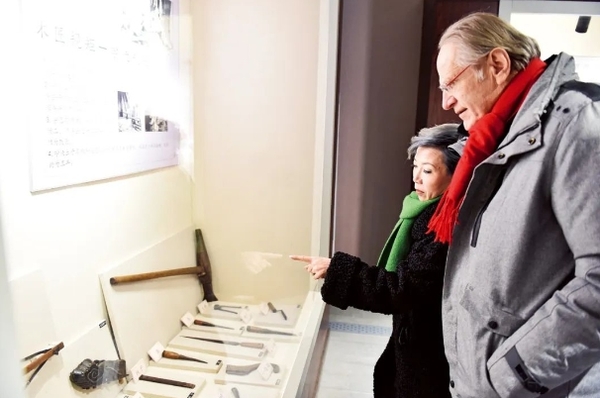Enjoying Life near Beijing Central Axis

A group of supervisors were nominated, earlier this year, to shoulder the responsibility of helping protect the cultural heritage of Beijing Central Axis. Running north to south through the center of the old city, Beijing Central Axis is an ensemble of building complexes and archeological sites, which exemplifies the ideal order of the Chinese capital. Among those nominated to be a supervisor, Tom Wolters was the only foreigner.
Wolters, a Dutch friend of China, and his Chinese wife, Li Wenjun, in 2004 settled their home in a traditional quadrangle courtyard in the Jingshan community. When standing on the Wanchun Pavilion, in Jingshan Park, the highest point of Beijing's old city, Beijing Central Axis can be clearly seen. "You have to go up, and then, you can see the axis in the context of the city," Wolters says. This, he tells Women of China, is an important reason why his family decided to live in Jingshan.

Wolters, an expert and consultant who specializes in urban ecology and environmental planning, previously worked for UN agencies, including UNDP (United Nations Development Programme), UNESCO (United Nations Educational, Scientific and Cultural Organization) and UN-Habitat (United Nations Human Settlements Programme). He has participated in many urban-development programs, worldwide, since the early 1970s.
During a 1991 high-level UN-China experts' workshop on tourism management, which was held in the then-just designated UNESCO World Heritage site, Mount Huangshan, in east China's Anhui Province, Wolters met Li, who was an interpreter during the workshop. They married in 1997, the year Wolters spent his first Spring Festival in China.
Wolters and Li say they were pleased to participate in the filming of a documentary promoting Beijing Central Axis to the world. As residents of Jingshan community, they tell viewers what daily life near the axis is really like. For example, they generally begin their day buying freshly cooked baozi (steamed and stuffed buns), doujiang (soybean milk) and youtiao (deep-fried dough sticks) at a breakfast stall in a hutong.

When she talks about what it means to help protect and promote Beijing Central Axis, Li says she and her husband are lucky. "Tom has his own expertise, for instance, his work experiences involving urban planning and the protection of architecture and the ecological environment. Besides, our home is situated almost next to Jingshan Park, which stands for a unique, central location of the axis. We have two sons, both of whom were born in Beijing, and both of whom have been raised in a traditional hutong. Our family belongs to Jingshan community. Jingshan Park is like a beautiful playground for our children," Li explains.
Why did Wolters decide to live in China? To be with his family here, of course. What's more, he has an "emotional bond" with Beijing Central Axis. Wolters once said he was impressed by the fascinating view after he climbed to Wanchun Pavilion. The artistic view, brought by symmetrical architectures, which are divided into two sides (east and west) by Beijing Central Axis, and the wisdom of planners for the old city of Beijing, triggered his interest in the capital city. Over the years, Wolters has read many books and reference materials recording the history of Beijing Central Axis.

"What is the relationship between Beijing Central Axis and the people living in neighboring communities? The value of the axis also lies in its connection with residents, and their communities," Wolters says. He observes the changes that have taken place along Beijing Central Axis, and he likes to tell his international friends how people from nearby communities have connected their daily lives with the protection of this axis.
Using his family as an example, Wolters says his youngest son, Ian, studied ballet in Tianqiao, in southern Beijing, when he was young. Ian's class normally lasted 90 minutes, and while Wolters waited for the class to end, he often wandered to Yongdingmen, in the southern section of the axis. "Especially if the weather was good, you could see a lot of residents in the neighborhood flying kites. Kites flying high in the blue sky, and embraced with wind, formed a typical scene there," Wolters recalls. He enjoys the peaceful, and interesting, lifestyle he has found along the axis, especially in southern Beijing.
"Our sons, Sjeng and Ian, both grew up in the hutong area of Jingshan community. They look more like foreigners, but they can speak fluent Chinese, even with 'standard' accent of the Beijing dialect," Li says, smiling. Although Wolters can only speak a small amount of Chinese, their neighbors in the hutong are familiar with their old friend, from Holland.

Life near Beijing Central Axis proceeds smoothly. Wolters and Li said they were glad to be interviewed by Women of China. As the couple strolled through Jingshan Park, they took photos of the bright-red lanterns hanging on trees. They were looking forward to their sons returning home from their universities in other cities.
"Sjeng studies stage direction in Shanghai. Ian continues studying ballet in Shenyang (in northeast China). I believe the most precious and remarkable memories of a person's life often rest in his/her childhood. Wherever my children have been to, Beijing and life nearby the axis will always be cherished in their hearts. This will remain to be my family's special connection with our home, in China," Li concludes.
Photos from Zhang Jiamin and Interviewees
(Women of China English Monthly February 2024)
Please understand that womenofchina.cn,a non-profit, information-communication website, cannot reach every writer before using articles and images. For copyright issues, please contact us by emailing: website@womenofchina.cn. The articles published and opinions expressed on this website represent the opinions of writers and are not necessarily shared by womenofchina.cn.








.jpg)

 WeChat
WeChat Weibo
Weibo 京公网安备 11010102004314号
京公网安备 11010102004314号